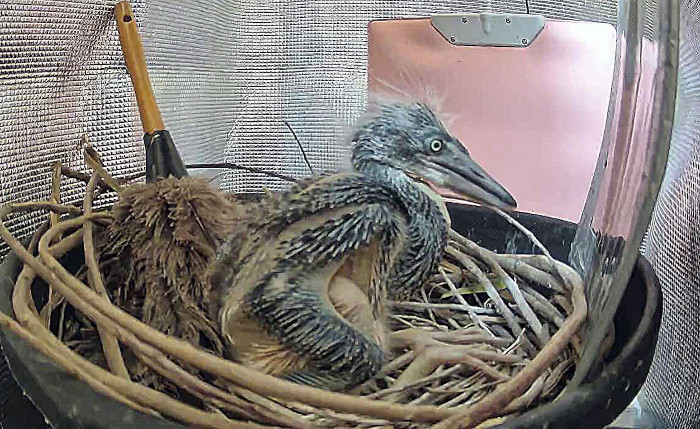Japanese collaboration to save White-bellied Herons in Bhutan takes wings

at the White-bellied Heron Conservation Center, the Royal Society for Protection of Nature,
Bhutan, with guidance from Japanese captive breeding specialists of avian species.
To create a semi-natural environment where the chicks could coexist with other chicks,
a mirror and a duster were positioned near them.
(© Ms. Samten Lekey, Veterinary Officer from the White-bellied Heron Conservation Center,
the Royal Society for Protection of Nature, Bhutan,
and Professor Satoshi Shimano from Hosei University,)
The White-bellied Heron (WBH), the world's second-largest heron, is a symbolic bird for the people of Bhutan and also a typical "umbrella species" that requires a habitat with a vast, preserved environment. In recent years, the WBH's habitat has been severely disturbed by human activities, and its population has decreased significantly.
As of 2024, it is estimated that there are fewer than 45 WBHs in the world, although the official count stands at 60. The WBH is endemic to the Indian subcontinent, with approximately 25 individuals sighted in Bhutan. Conservation efforts for the species are limited and fragmented across the region.
In 2021, the Royal Society for Protection of Nature (RSPN) in Bhutan decided to begin efforts to artificially breed WBH outside their natural habitat (ex situ conservation), and the White-bellied Heron Conservation Center (WBHCC) was constructed and began operation in 2022. The WBHCC, located in the mountainous areas of south-central Bhutan, a six-hour drive from Bhutan's capital, Thimphu, is supported by the Royal Government of Bhutan, international donors, agencies, and global philanthropists.
The center maintains three WBHs in a large aviary on its grounds. Two of these birds were collected as chicks from wild nests, and the other was rescued as a wounded bird. The center plans to collect not only chicks but also eggs from wild nests to artificially hatch them in an incubator. This was because monkeys were observed eating WBH eggs during incubation in monkey-populated areas.
Since WBH pairs build their nests on steep cliffs and high trees, collecting chicks and eggs is extremely dangerous. A single nest typically produces around four eggs. Only 3–4 WBH pairs have been confirmed in Bhutan, but this was a relatively large number compared to other countries. These efforts had been unsuccessful due to a limited number of well-trained staff and insufficiently developed hand-rearing techniques.
In 2023, the center collected and hatched three eggs, but all three chicks had to be euthanized due to genetic abnormalities resulting from inbreeding due to low population numbers. However, the RSPN planned to establish 16 founder populations (8 breeding pairs) by 2028 and release at least 50 herons in the wild by 2050 as part of the population restoration programs.
Back in 2018, Professor Satoshi Shimano from Hosei University, Japan, a dedicated conservation biologist, met a Bhutanese graduate student, Mr. Pema Khandu, who was working to conserve the WBH. Having witnessed the extinction of the Japanese original strains of the Oriental Stork and the Japanese Crested Ibis, Dr. Shimano readily volunteered to help, saying "I will do anything in my capacity to help. We must not let Bhutan make the same mistakes we made in Japan." The story of conservation efforts that followed is nothing short of a fairytale.
Professor Shimano contacted researchers he knew to discuss conserving the WBH. In 2023, Japanese veterinarians Dr. Takashi Nagamine and Dr. Yumiko Nakaya, from the Okinawa Wildlife Federation and the WBH Conservation Team, visited the WBHCC. They concluded that the chick deaths were likely due to hand-rearing techniques rather than genetic abnormalities.
A support team was formed, composed of experts from the Hyogo Park of the Oriental White Stork and several member associations affiliated with JAZA (Japanese Association of Zoos and Aquariums). These experts had been involved in the captive breeding of Oriental Storks, Okinawa Rails, and Japanese Crested Ibises. The team visited the WBHCC twice in March and April 2024, during the breeding season, taking the Japanese know-how overseas. They also provided continuous daily online support to Bhutan throughout the breeding season. Equipment and supplies were donated to the WBHCC.
Leg abnormalities were known to occur frequently in Crested Ibises and Oriental Storks during growth. Similar leg abnormalities were observed in the WBH that died in 2023 and in those hatched in 2024. Rei Matsumoto, a veterinarian and senior researcher at the Hyogo Park of the Oriental White Stork, instructed that the bedding material be changed to twigs of a thickness that the chicks could easily grasp. As a result, one of the two chicks showed improvement in its legs and began to grow well.
Matsumoto says, "There have been past cases where efforts to prevent the extinction of both the Crested Ibis and the Oriental Stork have failed. In order to prevent a repeat of this, I hope that by providing the knowledge that Japan has, we can increase the number of these birds, even if only a little."
Mr. Toshio Shiraishi, of the Yokohama City Preservation and Research Center, oversaw the hatching of eggs. He has experience breeding rare heron species, such as the Japanese Night Heron.
Even in Japan, it took more than twenty years to establish the artificial breeding technique for Crested Ibises and Oriental Storks. Professor Shimano says, "Japan, which knows the pain of having lost the endemic Japanese lineage and the subsequent efforts that followed, should be the one to make use of its own technique overseas. Everyone on the team is committed to supporting the WBH for the next 20 years." They are hopeful that, within five to 10 years, when the captive population rises to around 30 individuals, they will release a few into the wild.
Hosei University
20 Feb 2025
Share this story







